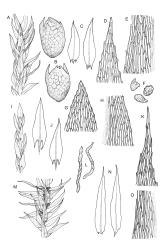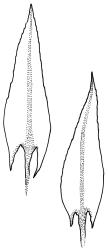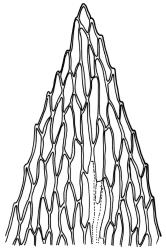- ≡ Webera camptotrachela Renauld & Cardot, Bot. Gaz. 13: 199 (1888)
Plants small to medium-sized, slender, yellow-green, dull or weakly lustrous, forming turves on mineral soil. Stems 5–10(–15) mm, unbranched or nearly so, pale above, usually red near base, sparsely beset with coarsely papillose red-brown rhizoids, in cross-section with thick-walled cortical cells and a central strand. Leaves ± uniformly distributed along stem, erect or weakly erect-spreading when moist, erect-appressed and weakly contorted when dry, ovate-lanceolate, acute, bluntly serrulate by projecting cells above, (0.7–)1.0–1.4 mm, plane, decurrent; mid laminal cells linear-rhomboid and mostly with oblique end walls, firm-walled, mostly 60–90 × c. 9 µm. Costa stout, slightly undulate, fading below the apex. Axillary gemmae abundant (to 12 or more) in axils of upper leaves of sterile shoots, spherical or obovoid, green, yellow-green, or orange, c. 105–130 × c. 75–90 μm (excluding stalk), with 1–4 peg-like and incurved apical leaf primordia, borne on uniseriate or biseriate stalks.
Dioicous. Perichaetia terminal, the perichaetial leaves narrowly lanceolate, longer and gradually grading into vegetative leaves, to 3.0 mm. Perigonia terminal, bulbiform, the perigonial bracts lanceolate and c. 2.0 mm. Sporophytes unknown in N.Z.
Renauld & Cardot 1888, pl. 16; Shaw 1981, figs 31–32; Smith 2004, fig. 200, 1.
The present species is dull rather than lustrous, and has consistently smaller and more numerous gemmae and less strongly decurrent leaves than P. australis. The leaf primordia of the gemmae are here short and peg-like rather than broadly triangular, as in P. australis. Pohlia camptotrachela is a duller plant with smaller gemmae borne on uniseriate or biseriate stalks in contrast to the lustrous and less-well-documented P. annotina, where the stalks are absent or inconspicuous.
SI: Nelson (Braeburn Track, Madmans Creek near Charleston), Canterbury (Temple Basin, Banks Peninsula), Westland (Lake Kaniere), Otago (Mt Cargill, Sullivan’s Dam, near Tahakopa, Lammermoor Range), Southland (Longwood Range, South Borland Burn).
Probably adventive. Reported from western North America and northern Europe by Shaw (1981). Smith (2004) recorded it from Britain, Europe north to Fennoscandia, and Macaronesia. Shaw & Ramsay (2013) recorded it from a single alpine site in N.S.W.
On mineral soil in disturbed, sometimes compacted, and usually insolated sites, with many collections from disturbed road or track margins. In the Longwood Range it occurred on the banks of a track-side drainage channel in a Dracophyllum longifolium–Coprosma–Astelia–Chionochloa shrubland. It grew on vertical soil in a roadside drainage ditch in mature Lophozonia menziesii forest near Tahakopa. Occurring on the South I. from 150 m (Madmans Creek) to 1400 m (Temple Basin). Bartramia papillata, Campylopodium capillaceum, Pleuridium subulatum, Trematodon suberectus, and Isotachis intortifolia are frequently associated. These habitats are consistent with the damp soil along a roadside site cited for a N.S.W. collection reported by Shaw & Ramsay (2013).
Pohlia camptotrachela was initially recorded in New Zealand by Fife (1984) from Madmans Creek. Subsequent collections show it to occur widely on the South I., but there are still no records from the North I. Perichaetia have been seen only in one specimen collected by P. Beveridge from near Tahakopa in the Catlins Region of Otago L.D., and the perichaetia description presented here is based on this collection (WELT M 039417).









